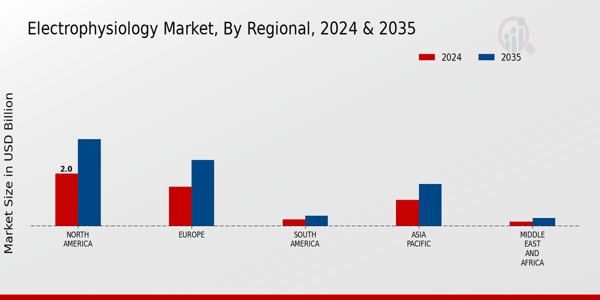Market Trends
Key Emerging Trends in the Electrophysiology Market
Restoring a normal cardiac rhythm with catheter ablation, particularly using radiofrequency and cryoablation procedures, is a minimally invasive method that shortens recovery periods and improves patient outcomes. This pattern is indicative of a larger movement in electrophysiology toward catheter-based therapies as the main form of therapy. The electrophysiology market is changing as a result of technological advancements, with an emphasis on sophisticated mapping and navigation systems. Electrophysiological treatments are performed more accurately and efficiently because to robotic assistance in navigation, augmented reality, and 3D mapping technology. Thanks to these advancements, cardiac structures may be seen in real time, allowing precise mapping of arrhythmias and focused ablation. The use of state-of-the-art technology demonstrates a dedication to maximizing the effectiveness of electrophysiological therapies. In the market for electrophysiology, remote monitoring of cardiac implanted electronic devices (CIEDs) is a noteworthy development. Healthcare professionals may remotely monitor patients' heart problems thanks to the remote monitoring features included into implanted devices including pacemakers, defibrillators, and cardiac monitors. This trend, which provides people with cardiovascular problems with ongoing monitoring and prompt management, is in line with the larger shift towards digital health solutions. The merging of imaging technology with electrophysiology is becoming more and more prominent. Comprehensive visualization and guiding during interventions are made possible by integrating electrophysiological methods with intracardiac echocardiography (ICE) and fluoroscopy. This trend improves patient and healthcare provider safety by lowering radiation exposure, improving procedure accuracy, and improving safety. A dedication to improving the accuracy of electrophysiological therapies is demonstrated by the inclusion of imaging technology. The market for electrophysiology is being impacted by atrial fibrillation (AF), which is becoming a more common cardiac arrhythmia. An growing number of pulmonary vein isolation and other AF ablation operations are being carried out to control and cure this prevalent arrhythmia. Better patient outcomes, tailored treatment plans, and more precise diagnosis are all facilitated by this trend. AI integration is a result of the convergence of cutting-edge computational technology with electrophysiological developments. Virtual consultations and telehealth are quickly becoming essential parts of patient treatment in electrophysiology. Telemonitoring of implanted devices, virtual consultations, and remote follow-ups improve patient participation and enable ongoing treatment. The COVID-19 pandemic has expedited this trend, which highlights the need of telemedicine in maintaining patient safety while guaranteeing accessibility and continuity of electrophysiological services. Innovation and research in the field of electrophysiological devices are being driven by partnerships and collaborations between healthcare institutions and device makers. The objective of these partnerships is to progress technologically, exchange knowledge, and create innovative remedies for intricate arrhythmias. The collaborative efforts of healthcare practitioners and industry stakeholders are crucial in advancing the quality of patient care and electrophysiological treatments. Adherence to safety regulations and standards is still a critical factor in the electrophysiology industry. To guarantee their efficacy and safety, electrophysiological devices must pass strict regulatory processes throughout development and approval. Manufacturers pledge to comply with legal regulations, secure required approvals, and uphold superior quality standards to guarantee patient safety during electrophysiological treatments. In electrophysiological therapy, patient-specificity and customization are becoming increasingly important. More efficient and individualized therapy is achieved by adjusting treatment plans in accordance with the unique anatomy and underlying problems of each patient. This pattern shows a dedication to maximizing results and attending to the particular requirements of patients receiving electrophysiological procedures.














Leave a Comment